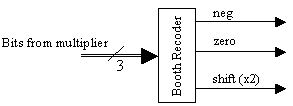1. 补码数
正数表示:
$ N = sum_{i=0}^{i=n-1}2^{i} $
负数表示
$ N = -[1+sum_{i=0}^{n-1}(1-a_i)2^i] $
经过推到合并,将an符号项加入,可以写为:
$ N = -a_n2^n+sum_{i=0}^{n-1}a_i2^i $
因而,两数相乘,可以用如下式子表示:
$ P = ( -y_n2^n+sum_{i=0}^{n-1}y_i2^i)( -a_x2^n+sum_{i=0}^{n-1}x_i2^i)) $
2. 减少部分积的数目
首先我们讨论通常情况下的乘法器原理。
如下示例:
0 0 1 0 1 1 y
0 1 0 0 1 1 x
0 0 1 0 1 1
0 0 1 0 1 1
0 0 0 0 0 0
0 0 0 0 0 0
0 0 1 0 1 1
0 0 1 1 0 1 0 0 0 1在该系统中,通过移位并相加的方法得到最终的结果。中间的每个横行就是部分积。部分积的个数与x的位数相同。
此运算为模2的运算。如果采用高基运算,即可减少部分积的数目。
模4的运算,对于Y而言,可以分为0Y, 1Y, 2Y, 3Y,但是3Y为高阶项,比较难以实现,于是考虑只用0Y, 1Y, 2Y实现模4运算。
由此出现了波兹编码。
3. 波兹编码
编码的方式是每个block里面3个数,并且会有overlaps,如下所示:
![]()
编码表如下:
| Block | Partial Product |
| 000 | 0 |
| 001 | 1 * Multiplicand |
| 010 | 1 * Multiplicand |
| 011 | 2 * Multiplicand |
| 100 | -2 * Multiplicand |
| 101 | -1 * Multiplicand |
| 110 | -1 * Multiplicand |
| 111 | 0 |
这里有个疑问,为什么001,010的partial product是一样的呢?
对LSB和MSB的处理:
LSB可以往后补0,MSB可以往前补0。
4. 波兹编码乘法器的计算示例:
(1)
0 0 1 0 1 1 , multiplicand
0 1 0 0 1 1 , multiplier
1 1 -1 , booth encoding of multiplier
1 1 1 1 1 1 0 1 0 0 , negative term sign extended
0 0 1 0 1 1
0 0 1 0 1 1
0 0 0 0 1 , error correction for negation
0 0 1 1 0 1 0 0 0 1 , discarding the carried high bit
(2)
0 1 1 0 0 1 , multiplicand
1 0 0 1 1 1 , multiplier
1 -2 2 -1 , booth encoding of multiplier
1 1 1 1 1 0 0 1 1 0 , negative term sign extended
0 0 0 0 1 1 0 0 1 0
1 1 0 0 1 1 0 1
0 1 1 0 0 1
0 0 0 0 1 , error correction for negation
0 0 0 0 1 , error correction for negation
0 0 1 1 1 1 0 0 1 1 1 1 , discarding the carried high bit
注意这里乘数的最高位是1,因此需要前面补0。并且有两个负值,因此需要进行相应位数的两次error correction。
5. 波兹编码的实现
有一种实现方式如图所示。

neg为符号位,zero为系数1,shift为系数2。
参考:
http://www.geoffknagge.com/fyp/booth.shtml